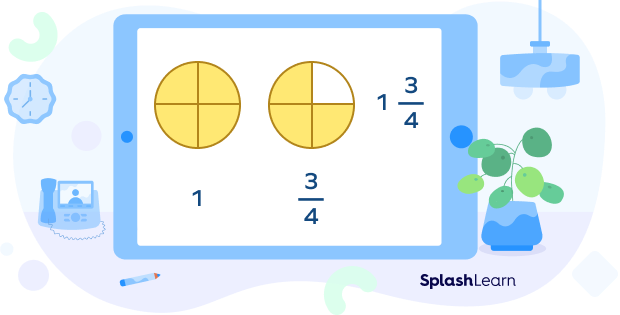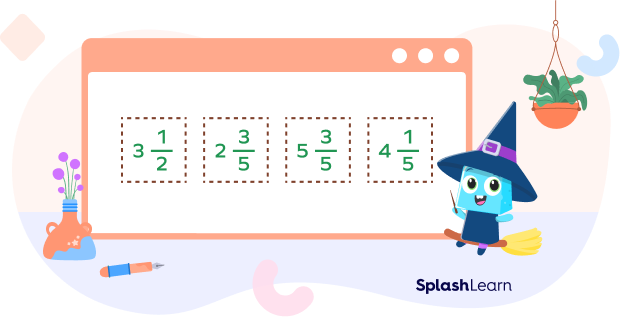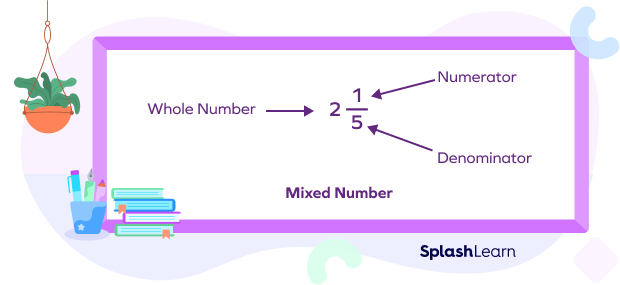What Are Mixed Numbers
A mixed number is a whole number and a proper fraction represented together. It generally represents a number between any two whole numbers.
Look at the given image, it represents a fraction that is greater than 1 but less than 2. It is thus a mixed number.

Some other examples of mixed numbers are:

 Begin here
Begin here
Parts of a mixed number
A mixed number is formed by combining three parts: a whole number, a numerator, and a denominator. The numerator and denominator are part of the proper fraction that makes the mixed number.

Related Worksheets
Converting Mixed Numbers to Improper Fractions
- Multiply the whole number by the denominator of the fraction.
- Add the answer obtained from Step 1 to the numerator of the fraction.
- Write an answer obtained from Step 2 over the denominator.
Let us suppose we have to convert $2\frac{2}{3}$ into an improper fraction.
Step 1: Multiply 3 and 2, we get $3 \times 2 = 6$.
Step 2: Add 6 and 2, we get $6 + 2 = 8$
Step 3: The fraction obtained is $\frac{8}{3}$.
Multiplying a Mixed Number by a Whole Number
Step 1: Convert the mixed number into an improper fraction.
Step 2: Rewrite the whole number as a fraction with the denominator 1.
Step 3: Multiply two fractions by multiplying the numerators and denominators separately.
Step 4: Convert it into simplified form if required.
Suppose we have to multiply 3 and $2\frac{1}{2}$.
$2\frac{1}{2}=\frac{2\times2+1}{2}=\frac{5}{2}$
$3\times\frac{5}{2}=\frac{3}{1}\times\frac{5}{2}=\frac{15}{2}=7\frac{1}{2}$
Multiplying a Mixed Number by a Fraction
Step 1: Convert the mixed number into an improper fraction.
Step 2: Multiply the numerators of the fraction and multiply the denominators of the fraction.
Step 3: Convert it into simplified form if required.
Suppose we have to multiply $\frac{2}{5}$ and $3\frac{1}{2}$.
$3\frac{1}{2}=\frac{3\times2+1}{2}=\frac{7}{2}$
$\frac{2}{5}\times\frac{7}{2}=\frac{14}{10}=\frac{7}{5}=1\frac{2}{5}$
Multiplying Two Mixed Numbers
Step 1: Convert the mixed numbers into improper fractions.
Step 2: Multiply the two fractions by multiplying the numerators and denominators separately.
Step 3: Convert it into simplified form if required.
For example: Multiply $4\frac{1}{2}$ and $3\frac{1}{3}$.
$4\frac{1}{2}=\frac{4\times2+1}{2}=\frac{9}{2}$
$3\frac{1}{3}=\frac{3\times3+1}{3}=\frac{10}{3}$
$4\frac{1}{2}\times3\frac{1}{3}=\frac{9}{2}\times\frac{10}{3}=\frac{90}{6}=15$
Conclusion
In this article, we learnt about multiplying mixed numbers. Mixed numbers are also known as mixed fractions. To read more such informative articles on other concepts, do visit our website. We, at SplashLearn, are on a mission to make learning fun and interactive for all students.
Solved Examples On Multiplying Mixed Numbers
1. Multiply $5\frac{3}{7}$ by the multiplicative inverse of $7\frac{3}{5}$.
Solution: $5\frac{3}{7}=\frac{5\times7+3}{7}=\frac{38}{7}$
$7\frac{3}{5}=\frac{7\times5+3}{5}=\frac{38}{5}$
Multiplicative inverse of $\frac{38}{5}$ is $\frac{5}{38}$.
Product $= \frac{38}{7}\times\frac{5}{38}=\frac{5}{7}$
2. Emma walks 523 miles in a day. How much distance will she cover in 9 days?
Solution: Distance traveled by Emma in 1 day $= 5\frac{2}{3}$miles$=\frac{17}{3}$ miles.
Distance traveled by Emma in 9 days $= 9\times\frac{17}{3}= 51$ miles
3. Multiply $6\frac{2}{5}\times\frac{3}{4}$.
Solution: $6\frac{2}{5}=\frac{6\times5+2}{5}=\frac{32}{5}$
$\frac{32}{5}\times \frac{3}{4}=\frac{32\times3}{5\times4}=\frac{96}{20}=\frac{24}{5}=4\frac{4}{5}$
Practice Problems On Multiplying Mixed Numbers
Multiplying Mixed Numbers - Definition With Examples
Which of these is the first step to multiply mixed numbers?
Converting the mixed numbers to improper fractions The first step to multiply mixed numbers is to convert them into improper fractions.
On multiplying $10\frac{1}{6}$ by $2\frac{2}{11}$, we get ____.
$10\frac{1}{6}\times\frac2{2}{11}=\frac{61}{6}\times\frac{24}{11}=\frac{244}{11}=22\frac{2}{11}$, i.e., a mixed number
The value of $4\frac{2}{9}\times1\frac{1}{7}$ is:
$4\frac{2}{9}\times1\frac{1}{7}=\frac{38}{9}\times{8}{7}=\frac{304}{63}=4\frac{52}{63}$
Frequently Asked Questions On Multiplying Mixed Numbers
Are same denominators required when multiplying two or more mixed numbers?
No. We don’t need the same denominators to multiply two or more mixed numbers. We can even multiply unlike fractions.
What is another name for mixed numbers?
The other name for mixed numbers is mixed fractions.
Is the product of a mixed number with another mixed number always a mixed number?
No. A mixed number is always greater than 1. So, the product of 2 numbers greater than 1 will always be greater than 1, i.e., a mixed/whole number.





















